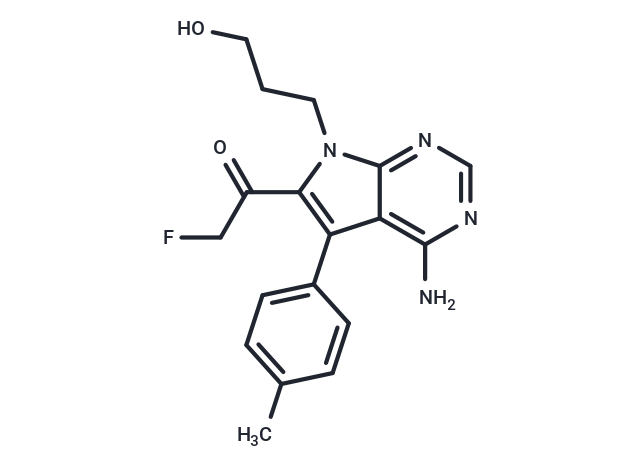Shopping Cart
Remove All Your shopping cart is currently empty
Your shopping cart is currently empty
FMK is an irreversible inhibitor of RSK2 kinase.

| Pack Size | Price | USA Warehouse | Global Warehouse | Quantity |
|---|---|---|---|---|
| 1 mg | $68 | In Stock | In Stock | |
| 2 mg | $97 | In Stock | In Stock | |
| 5 mg | $177 | In Stock | In Stock | |
| 10 mg | $317 | In Stock | In Stock | |
| 25 mg | $538 | In Stock | In Stock | |
| 50 mg | $777 | In Stock | In Stock | |
| 100 mg | $1,090 | In Stock | In Stock | |
| 500 mg | $2,170 | - | In Stock | |
| 1 mL x 10 mM (in DMSO) | $197 | In Stock | In Stock |
| Description | FMK is an irreversible inhibitor of RSK2 kinase. |
| In vitro | Pretreatment of ARVMs with 3 μM FMK mitigates the increase in Ser386 phosphorylation without affecting Thr577 phosphorylation [1]. FMK selectively inhibits a limited range of protein kinases, notably including protein tyrosine kinases such as Src, Lck, Yes, and Eph-A2, alongside S6K1. It does not inhibit RSK when the N-terminal kinase domain is activated independently of the C-terminal domain [2]. FMK deactivates the CTD auto-kinase activity of RSK1 and RSK2 with notable specificity in mammalian cells, reducing FGFR3-induced cytokine-independent growth in Ba/F3 cells and hindering cytokine-independent proliferation prompted by FGFR3 [3]. |
| Kinase Assay | To determine the ability of FGFR3 to phosphorylate RSK2, 500 ng of purified recombinant RSK2 variants are incubated with 500 ng of recombinant active FGFR3 in 10 mM HEPES (pH 7.5), 150 mM NaCl, 1 mM DTT, 0.01% Triton-X-100, 10 mM MnCl2, and 200 μM ATP for 30 min at 30°C. Phosphorylation of Y529 RSK2 is detected by specific phospho-antibody. To determine kinase activity of RSK2 CTD variants, purified recombinant RSK2 CTD proteins (500 nM) are incubated with 500 nM of active ERK in 20 mM HEPES [pH 8.0], 10 mM MgCl2, 2 mM tris-(2-carboxyethyl)-phosphine (TCEP), and 200 μM ATP for 1 hr at 30°C. Kinase reactions are initiated by the addition of 5 μCi of [γ-32P] ATP and 100 μM peptide substrate (CTD-tide), followed by incubation for 20 min at room temperature. Kinase activity is determined using the standard disk phospho-cellulose assay [3]. |
| Cell Research | RSK2 expressing Ba/F3 cell lines are generated by retroviral transduction as described by using Ba/F3 cells stably expressing FGFR3 TDII with pMSCV-puro plasmids encoding myc-tagged RSK2 variants, followed by antibiotic selection. For cell viability assays, 1×10^5 Ba/F3 cells stably expressing FGFR3 are cultured in 24-well plates with media containing increasing concentrations of FMK, acidic FGF (10 nM), and heparin (30 μg/mL) in the absence of IL-3. The relative cell viability at each experimental time point is determined by using the Celltiter96AQueous One solution proliferation kit [3]. |
| Molecular Weight | 342.37 |
| Formula | C18H19FN4O2 |
| Cas No. | 821794-92-7 |
| Smiles | Cc1ccc(cc1)-c1c(C(=O)CF)n(CCCO)c2ncnc(N)c12 |
| Relative Density. | 1.36 g/cm3 |
| Storage | Powder: -20°C for 3 years | In solvent: -80°C for 1 year | Shipping with blue ice/Shipping at ambient temperature. | |||||||||||||||||||||||||||||||||||
| Solubility Information | H2O: Insoluble DMSO: 90 mg/mL (262.87 mM), Sonication is recommended. | |||||||||||||||||||||||||||||||||||
| In Vivo Formulation | 10% DMSO+40% PEG300+5% Tween 80+45% Saline: 3.3 mg/mL (9.64 mM), Sonication is recommended. Please add the solvents sequentially, clarifying the solution as much as possible before adding the next one. Dissolve by heating and/or sonication if necessary. Working solution is recommended to be prepared and used immediately. The formulation provided above is for reference purposes only. In vivo formulations may vary and should be modified based on specific experimental conditions. | |||||||||||||||||||||||||||||||||||
Solution Preparation Table | ||||||||||||||||||||||||||||||||||||
DMSO
| ||||||||||||||||||||||||||||||||||||
| Size | Quantity | Unit Price | Amount | Operation |
|---|

Copyright © 2015-2026 TargetMol Chemicals Inc. All Rights Reserved.